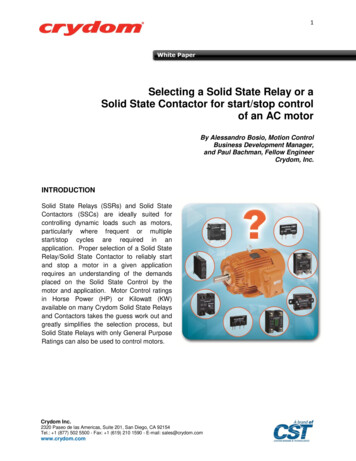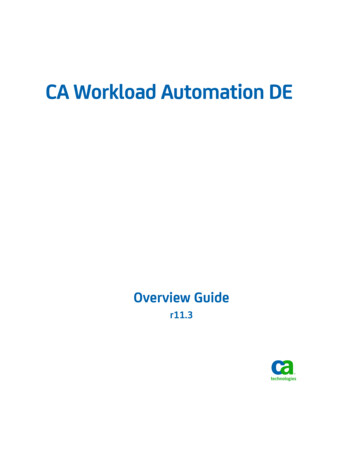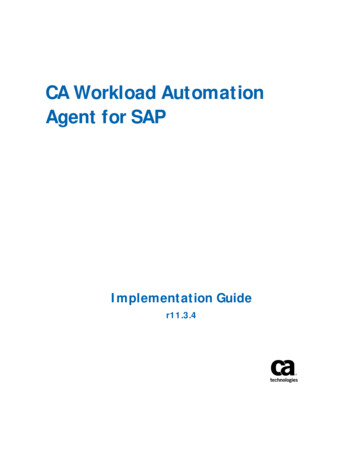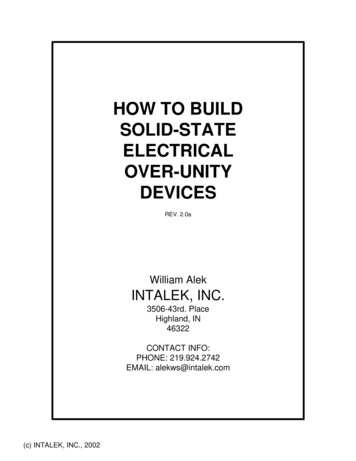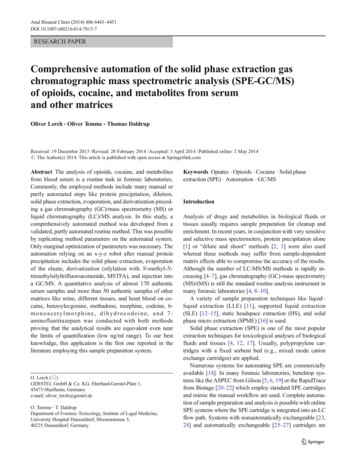
Transcription
Anal Bioanal Chem (2014) 406:4443–4451DOI 10.1007/s00216-014-7815-7RESEARCH PAPERComprehensive automation of the solid phase extraction gaschromatographic mass spectrometric analysis (SPE-GC/MS)of opioids, cocaine, and metabolites from serumand other matricesOliver Lerch & Oliver Temme & Thomas DaldrupReceived: 19 December 2013 / Revised: 28 February 2014 / Accepted: 3 April 2014 / Published online: 2 May 2014# The Author(s) 2014. This article is published with open access at Springerlink.comAbstract The analysis of opioids, cocaine, and metabolitesfrom blood serum is a routine task in forensic laboratories.Commonly, the employed methods include many manual orpartly automated steps like protein precipitation, dilution,solid phase extraction, evaporation, and derivatization preceding a gas chromatography (GC)/mass spectrometry (MS) orliquid chromatography (LC)/MS analysis. In this study, acomprehensively automated method was developed from avalidated, partly automated routine method. This was possibleby replicating method parameters on the automated system.Only marginal optimization of parameters was necessary. Theautomation relying on an x-y-z robot after manual proteinprecipitation includes the solid phase extraction, evaporationof the eluate, derivatization (silylation with N-methyl-Ntrimethylsilyltrifluoroacetamide, MSTFA), and injection intoa GC/MS. A quantitative analysis of almost 170 authenticserum samples and more than 50 authentic samples of othermatrices like urine, different tissues, and heart blood on cocaine, benzoylecgonine, methadone, morphine, codeine, 6monoacetylmorphine, dihydrocodeine, and 7aminoflunitrazepam was conducted with both methodsproving that the analytical results are equivalent even nearthe limits of quantification (low ng/ml range). To our bestknowledge, this application is the first one reported in theliterature employing this sample preparation system.O. Lerch (*)GERSTEL GmbH & Co. KG, Eberhard-Gerstel-Platz 1,45473 Muelheim, Germanye-mail: oliver lerch@gerstel.deO. Temme : T. DaldrupDepartment of Forensic Toxicology, Institute of Legal Medicine,University Hospital Duesseldorf, Moorenstrasse 5,40225 Duesseldorf, GermanyKeywords Opiates . Opioids . Cocaine . Solid phaseextraction (SPE) . Automation . GC/MSIntroductionAnalysis of drugs and metabolites in biological fluids ortissues usually requires sample preparation for cleanup andenrichment. In recent years, in conjunction with very sensitiveand selective mass spectrometers, protein precipitation alone[1] or “dilute and shoot” methods [2, 3] were also usedwhereat these methods may suffer from sample-dependentmatrix effects able to compromise the accuracy of the results.Although the number of LC-MS/MS methods is rapidly increasing [4–7], gas chromatography (GC)-mass spectrometry(MS)/(MS) is still the standard routine analysis instrument inmany forensic laboratories [4, 8–10].A variety of sample preparation techniques like liquid–liquid extraction (LLE) [11], supported liquid extraction(SLE) [12–15], static headspace extraction (HS), and solidphase micro extraction (SPME) [16] is used.Solid phase extraction (SPE) is one of the most popularextraction techniques for toxicological analyses of biologicalfluids and tissues [4, 12, 17]. Usually, polypropylene cartridges with a fixed sorbent bed (e.g., mixed mode cationexchange cartridges) are applied.Numerous systems for automating SPE are commerciallyavailable [18]. In many forensic laboratories, benchtop systems like the ASPEC from Gilson [5, 6, 19] or the RapidTracefrom Biotage [20–22] which employ standard SPE cartridgesand mimic the manual workflow are used. Complete automation of sample preparation and analysis is possible with onlineSPE systems where the SPE cartridge is integrated into an LCflow path. Systems with nonautomatically exchangeable [23,24] and automatically exchangeable [25–27] cartridges are
4444available. Online coupling of SPE to GC is less common andmore complex [12] but an important step to reduce manualwork and handling errors.Numerous methods for the analysis of opioids, cocaine,and metabolites in different matrices were published. Thecompounds were analyzed from different matrices like urine[9, 28, 29], whole blood, serum, plasma [5, 9, 7], saliva [6],hair [8], or post-mortem samples [17]. In this study, acompletely automated SPE-GC/MS method was developedfrom a validated, partly automated (SPE) analysis method.Automation is performed by different modules attached to anx-y-z robot. This allows mimicking the manual workflow ofsample dilution, SPE, evaporation, derivatization, and sampleinjection. Almost 170 authentic serum samples and more than50 authentic samples of other matrices were analyzed inparallel with both methods. Equivalence of results therefore,the validity of the method and the suitability of the automatedsystem for routine forensic analysis, should be proven by thisstudy design.O. Lerch et al.from Macherey-Nagel (Dueren, Germany) for the partlyautomated method and from Sigma-Aldrich (Taufkirchen,Germany) for the automated method. Bond Elut Certify130 mg, 3 ml format SPE cartridges from AgilentTechnologies (Waldbronn, Germany) were used. For automated solid phase extraction, these cartridges were cut at the top,equipped with a transport adapter and a disposable cannula(Fig. 1). Cartridges in such format are commercially availablefrom other vendors like Macherey & Nagel, Sigma-Aldrich,Phenomenex, and Bekolut.For solid phase extraction, 0.15 M acetic acid, a phosphatebuffer of pH 7.9 (4.49 g Na2HPO4 0.2 g KH2PO4 ad 400 mlH2O), and a mixture of dichloromethane/isopropanol/25 %ammonia solution 40/10/1 (v/v/v) for analyte elution wereprepared. A mixture of isooctane/MSTFA 19/1 (v/v) was usedfor manual derivatization and a mixture of isooctane/pyridine/MSTFA 14/5/1 (v/v/v) for automated derivatization.Inlet liners and injection vials were deactivated using asolution of 5 % dichlorodimethylsilane in toluene.InstrumentationMaterials and methodsSolvents, reagents, standards, and materialsAll analytes and deuterated analogs were certified standards.7-Aminoflunitrazepam (1 mg/ml in acetonitrile) anddihydrocodeine (1 mg/ml in methanol) were purchased fromLipomed (Arlesheim, Switzerland). 7-Aminoflunitrazepamd7, 6-monoacetylmorphine, 6-monoacetylmorphine-d3 (each0.1 mg/ml in acetonitrile), methadone, morphine, morphined3, codeine, codeine-d3, dihydrocodeine-d6 (each 0.1 mg/mlin methanol), methadone-d9, benzoylecgonine,benzoylecgonine-d3 (each 1 mg/ml in methanol), cocaine,and cocaine-d3 (each 1 mg/ml in acetonitrile) were purchasedfrom LGC Promochem (Wesel, Germany). For calibration andsolvent quality controls, multi-compound solutions and onemulti-compound internal standard solution containing deuterated analogs of every analyte were prepared in methanol. Each20 μl of the internal standard solution was added to samples,calibration samples, and quality controls. Blood, urine, andtissue samples were taken from authentic forensic cases of theInstitute of Legal Medicine (Duesseldorf, Germany). Internalcontrols consisting of drug-negative serum (given by theCenter of Haemostaseology, University HospitalDuesseldorf, Germany) and the above-mentioned standardswere prepared by the Institute of Legal Medicine. The externalcontrols were certified testing materials (lyophilized serum“Medidrug BTMF 2 S-plus” purchased from Medichem,Steinenbronn, Germany).All solvents and salts were of analytical grade and purchased from VWR (Darmstadt, Germany). N-Methyl-Ntrimethylsilyltrifluoroacetamide (MSTFA) for silylation wasMeasurements with the partly automated, validated analysismethod were conducted on a 7890 GC/5975 mass selectivedetector (MSD) equipped with an HP-5MS column 30 m, di0.25 mm, and df 0.25 μm. A 7683B autosampler was used forinjection into a hot split/splitless inlet (all AgilentTechnologies). For solid phase extraction, a RapidTrace SPEWorkstation (Biotage, Uppsala, Sweden) and for evaporationof the eluates a heating block (Medax, Neumuenster,Germany) with ten nitrogen-streamed vial positions (Gebr.Liebisch, Bielefeld, Germany) were used.Comprehensive automation of sample preparation—performed in a different laboratory—was based on aMultiPurpose Sampler (MPS) (Fig. 2, GERSTEL,Muelheim, Germany) which is a flexible platform with numerous modules available (e.g., for centrifugation and filtration) so that different sample preparation methods can beautomated. It carried two syringes, one 2.5 ml for samplepreparation steps and one 10 μl for sample injection into aFig. 1 Solid phase extraction (SPE) cartridges. Top: Solid phase extraction cartridge equipped for automated SPE. Bottom: Standard solid phaseextraction cartridge
Automation of the SPE-GC/MS of opioids, cocaine, and metabolites4445Fig. 2 System for automateddilution, solid phase extraction,eluate evaporation, derivatization,injection, and GC/MS analysis.X-y-z dual head roboticautosampler with followingmodules (from right to left):evaporation station, 2 solventfilling station, SPE module, trayfor sample vials, tray for SPEcartridges, tray for empty eluatevials, wash station, and agitatorProgrammed Temperature Vaporization (PTV) inlet (CooledInjection System CIS 4, GERSTEL) coupled to a 6890 GC/5975 MSD (Agilent Technologies). Separation was done onan Rxi-5Sil MS column 30 m, di 0.25 mm, and df 0.25 μmfrom Restek (Bad Homburg, Germany) having very similarretention characteristics as the HP-5MS. Additionally, theautosampler was equipped with a module for SPE, one forevaporation of solvents under controlled vacuum and temperature (multi-position eVAPoration station, mVAP), one forshaking under controlled temperature (Agitator), and one forsupplying large volumes of solvents (Solvent Filling Station 2,SFS 2, all GERSTEL). All solvents and samples were delivered by the 2.5-ml syringe which included a gas supply fordrying of SPE cartridges.The RapidTrace SPE Workstation was controlled viaRapidTrace SPE Workstation software (Biotage). All MPSsample preparation steps were flexibly combined in and controlled by Maestro software (GERSTEL). The sequentialsample preparation steps were automatically overlapped withchromatographic runs and other waiting times so that the GC/MS-system is effectively used. A scheduler window gives agraphical overview over the complete sequence and showswhat step is currently executed. ChemStation software(Agilent Technologies) was used to control the GC/MS system and to evaluate the recorded chromatograms.Analysis methodsCommon steps of sample preparationAll liquid samples (urine, blood, serum) and serum controlswere handled in the same way: proteins were precipitated bydropwise addition of a mixture of 0.6 ml sample, 0.1 ml water,and 20 μl internal standard solution to a mixture of 1 mlacetonitrile and 0.1 ml isopropanol. After mixing and centrifugation (RCF 17,530 g), an aliquot of 0.75 ml of the supernatant was taken for the partly automated analysis method.Another aliquot of 0.75 ml was collected and stored in thefreezer at 20 C for later analysis with the automated system.The storage period for the supernatants ranged from somedays to several months.Tissues (brain and kidney, native and lyophilized) werehomogenized with an Ultra Turrax. An aliquot of approximately 0.6 g was weighed and handled like the liquidsabove, whereas the acetonitrile/isopropanol solution wasgiven to the sample mixture for protein precipitation. Theexact weight was noted for calculation of analyteconcentrations.Sample preparation: partly automated, validated routinemethodA 0.75-ml aliquot of the supernatant of the protein precipitation was diluted with 4.25 ml of phosphate buffer, and the SPEcartridge was conditioned with 2 ml methanol and 2 ml phosphate buffer. After addition of the diluted sample, the cartridgewas washed with 2 ml water, 2 ml acetic acid (0.15 M), and2 ml methanol, shortly dried with nitrogen, and eluted with2 ml of the mentioned elution solvent.The eluate was evaporated to dryness in a stream ofnitrogen at 60 C and reconstituted in 0.2 ml of the derivatization solution. After shaking and incubating for 30 min at90 C, an aliquot of 2 μl was injected into the GC/MS via ahot inlet at 270 C.
4446O. Lerch et al.Protein id Phase nDerivatizationInjectionFig. 3 Scheme of the sample preparation workflow indicating automatedparts of both methodsautomated evaporation in the mVAP station. Therefore, anelution profile of the analytes from the SPE cartridge wasrecorded by fractionated elutions with portions of solventdetermining the main analytes containing fractions. The evaporation of the eluate was done in the mVAP station at 70 C,300 rpm shaking, and a pump vacuum of 8 kPa. Evaporationtime was optimized and finally set to a value of 6 min forreliable evaporation to dryness. In order to speed up themethod, the derivatization procedure was modified to thedescribed solvent composition (see “Solvents, reagents, standards, and materials” section) and a reaction time of 5 min.An aliquot of 2 μl of the derivatized eluate was injectedinto the CIS 4 (PTV inlet) at 50 C. The inlet was heated with12 C/s to 280 C held for 5 min.Sample preparation: completely automated methodAnalysis parameters for GC/MSThe completely automated method was performed analogously to the partly automated method (Fig. 3) described beforewith some adaptations: Since no adequate vial for taking upthe diluted sample (5 ml) was available, a part of the dilutionwas done in the autosampler syringe before injection into theSPE cartridge. For this, the original sample (supernatant of theprotein precipitation) was diluted 1:1 with 0.75 ml of phosphate buffer. Half of this diluted sample (0.75 ml) was aspirated into the syringe followed by 1.75 ml phosphate bufferresulting in the same dilution as in the partly automatedmethod. The syringe content was injected into the SPE cartridge, and the procedure was repeated to transfer the entiresample.Furthermore, the elution volume was adapted to speed upevaporation and since the preferred elution vial (2 ml format ischeaper than 4 ml format) could not be filled too high for laterTable 1 Quantifier and qualifierions for analytes and internalstandardsaQuantifier/qualifier ion used inpartly automated analysis methodbQuantifier/qualifier ion used infully automated analysis methodSeparation was performed on the named columns with constant helium flow of 1 ml/min and the following temperatureprogram: 140 C (1 min), 120 C/min, 225 C (5.29 min),120 C/min, 275 C (5.2 min), and post-run 300 C (2.5 min)resulting in a cycle time of around 20 min. The MSD wasoperated in single ion monitoring (SIM) mode recording onequantifier and two qualifier masses (Table 1).Deuterated analogs were used for every analyte, and calibration was done via standards in pure methanol. The calibration solution and the methanolic control samples were handledanalogously to the eluates. Nine calibration levels were measured in duplicate. Calibrations ranged from 25 to 1,500 ng/ml(methadone), from 50 to 1,500 ng/ml (benzoylecgonine), from5 to 150 ng/ml (codeine), from 5 to 300 ng/ml (cocaine,dihydrocodeine, morphine), and from 2.5 to 150 ng/ml (7-Retention time on Rxi-5MS, minQuantifier, m/zQualifier, 182185361364223226a, 303b429432371374303, 198306, 201256, 346259, 349294, 236303a, 318b, 242220, 401223, 404234, 343237, 02373379326b, 355a362340, 400343, 403315, 358318, 364326a, 356a, 327b, 354b333, 363
Automation of the SPE-GC/MS of opioids, cocaine, and metabolites4447Table 2 Validation data of the partly automated routine SD %Time-different intermediateprecisiona, RSD %Truenessa,bias %Extractionefficiencya, .8 4.6 8.9 1.0 01503001506.83.94.17.011.35.55.88.6 2.3 12.4 2.8 5.51187861127LOD limits of detection, LOQ limits of quantification, ULOC and upper limits of calibration, RSD relative standard deviationaConcentrations: 80 ng/ml for benzoylecgonine and methadone; 16 ng/ml for cocaine, morphine, and dihydrocodeine; 4 ng/ml for codeine, 6monoacetylmorphine, and 7-aminoflunitrazepamaminoflunitrazepam, 6-monoacetylmorphine), respectively,and were calculated for 0.6 ml serum samples. Calibrationfrom solvent standards is often used in forensic toxicology andis accepted by the Society of Toxicological and ForensicChemistry (GTFCh) if equivalence with matrix calibrationcan be proven.In between authentic case samples, control samples likenegative, low concentration, high concentration, external, andmethanolic control were analyzed. According to GTFCh recommendations, a blank injection of pure derivatization solution was done after every sample, quality control, and calibration sample.Results and discussionPartly automated, validated routine methodThe routine method was validated according to the GTFChguidelines [30]. Validation data are presented in Table 2.Concentrations of the analytes in the quality controls associated with the sequences were within the allowed tolerancerange (according to the GTFCh recommendations of 30 and 40 % near the limit of quantification (LOQ), respectively)[30]. The described method is being used for routine analysesin the Institute of Legal Medicine in Duesseldorf for severalyears. All proficiency tests were passed successfully. Theresults of the analyzed routine samples were taken as referencefor the automated system in order to prove its validity.Completely automated methodThe partly automated method could be successfully transferred to the completely automated system starting with thedilution of the sample (after protein precipitation) and endingwith the injection into the GC/MS. Most parameters could bereplicated without need for change. Some parameters wereadapted for different reasons discussed in the following.The in-syringe dilution worked properly. No carryover forany of the compounds could be detected when extracting100Fig. 4 SPE elution profile for allanalytes included in this nitrazepam2010Fraction of elution volume, ml2.01.9 -1.91.8 -1.81.7 -1.71.6 -1.61.5 -1.50.8 -0.80.7 -0.70.6 -0.60.5 -0.50.4 -.400-0Eluted portion, %Cocaine70
4448600000Cocaine500000Benzoylecgonine400000Peak areaFig. 5 Optimization ofderivatization reagentcomposition for the completelyautomated method. Purestandards were derivatized withdifferent reagents at 90 C for30 minO. Lerch et 00Composition isooctane/pyridine/MSTFA(v/v/v)blank serum samples after analyte-positive samples.According to the elution profile (Fig. 4), the elution volumewas adjusted to 1.9 ml where the first 0.6 ml was discardedand the following 1.3 ml was collected in the elution vial. Thisvolume is adequate for evaporation from a 2-ml vial in themVAP station. Although the elution solvent consists mainly ofthe very volatile dichloromethane, the evaporation under controlled vacuum, heating, and shaking was very smooth andrepeatable without any boiling retardation.The derivatization procedure could be shortened from 30 to5 min at 90 C by using a different reagent mixture consistingof isooctane/pyridine/MSTFA 14/5/1 (v/v/v) instead ofisooctane/MSTFA 19/1 (v/v; see Figs. 5 and 6).For methadone and 7-aminoflunitrazepam, quantifier andqualifier masses are needed to be adapted since ethadonePeak areaFig. 6 Optimization ofderivatization time for thecompletely automated method.Spiked serum samples wereextracted and the eluate wasderivatized with isooctane/pyridine/MSTFA 14/5/1 (v/v/v) at90 C for different timesoccurred. In the case of 7-aminoflunitrazepam, probably siloxanes from vial septa also showing m/z 355 and 356coeluted with the analyte. Choosing m/z 326, 327, and 354as quantifier/qualifiers could overcome this issue.All in all, the semiautomated method could readily betransferred to the automated system without major optimization steps.Almost 170 authentic serum samples and more than 50authentic samples of other matrices (urine, different tissues,heart blood) were analyzed. All samples were processed properly by the instrument without any failure. By overlappingsample preparation steps with the GC/MS run, a throughput ofaround 29 samples per day could be achieved which is comparable with the partly automated method. The possible automation of the protein precipitation step was not within vatization time, min30
Automation of the SPE-GC/MS of opioids, cocaine, and metabolitesscope of the present work because of the study design (twoaliquots of one sample after protein precipitation for parallelanalysis). All quantification results for the control samples butone for cocaine and one for benzoylecgonine in an externalcontrol sample (2 and 3 % below the allowed tolerance,respectively) were within the allowed tolerance ranges.Method comparisonResults of both methods are equivalent as visible in the doublelogarithmic line and Bland-Altman plots (Figs. 7 and 8 andTable 3). This is true for serum samples and also for other matrixsamples (urine, different tissues, heart blood). Results betweenthe method’s LOQ and the limit of detection (LOD) are included in the line plots (dashed black lines in Fig. 7) as well. Even inthis concentration range, the equivalence of both methods isobvious suggesting that LOQ and LOD for both methods arevery similar. This indirect validation approach of comparing alarge number of authentic samples reveals the accuracy andprecision of the comprehensively automated method.The analyses were run in different laboratories by differentpersonnel at different times revealing the ruggedness of theinstrumentation and both methods. Since only a couple ofsamples were positive for dihydrocodeine and 7aminoflunitrazepam, these results are not plotted. Samplesand quality control samples were also in good concordancefor these compounds.LOQs are in the range of other published methods, e.g.,Kjaergaard Bjork et al. achieved LOQs between 2.5 and10 ng/mL in whole blood analysis for the compoundsd100010010SerumOtherLOQ - ULOCLOD - LOQ10.10.1110100Concentration (MPS), ng/mlConcentration (MPS), ng/mla4449100010001001011Concentration (VAL), ng/ml1000100SerumOtherLOQ - ULOCLOD - LOQ1011101001000Concentration (MPS), ng/mlConcentration (MPS), ng/ml1001000e1000010000100010010SerumOtherLOQ - ULOCLOD - LOQ10.10.1Concentration (VAL), ng/ml1101001000Concentration (VAL), ng/mlf100001000100SerumOtherLOQ - ULOCLOD - LOQ101110100100010000Concentration (VAL), ng/mlFig. 7 Correlation of measured analyte concentrations in double logarithmic scale. Line with a slope of one (dashed black in the range fromLOD to LOQ and solid green in the range from LOQ to ULOC)—representing the complete equivalence of results—is shown. VAL validated partly automated method; MPS fully automated method performed ona MultiPurpose Sampler (MPS); ng/ml nanogram per milliliter orConcentration (MPS), ng/mlConcentration (MPS), ng/ml10Concentration (VAL), ng/mlbcSerumOtherLOQ - ULOCLOD - LOQ100010010SerumOtherLOQ - ULOCLOD - LOQ10.10.11101001000Concentration (VAL), ng/mlnanogram per gram if tissue is used, respectively; Other other matricesthan serum—urine, blood, lyophilized kidney tissue, heart blood, lyophilized, and native brain tissue; LOD limit of detection; LOQ limit ofquantification; ULOC upper limit of calibration. a Cocaine. bBenzoylecgonine. c Methadone. d Morphine. e Codeine. f 6Monoacetylmorphine
4450O. Lerch et al.d60%40%20%0%SerumOtherMean 1.96 SD 30%--20%--40%--60%050100150200250300Relative deviation (MPS / VAL)Relative deviation (MPS / VAL)a60%40%20%0%SerumOtherMean 1.96 SD 30%-20%-40%-60%0Average of VAL and MPS, ng/ml150200250300e60%40%20%0%SerumOtherMean 1.96 SD 30%-20%-40%-60%0250500750100012501500Relative deviation (MPS / VAL)Relative deviation (MPS / VAL)100Average of VAL and MPS, ng/mlb60%40%20%0%SerumOtherMean 1.96 SD 30%-20%-40%-60%0Average of VAL and MPS, ng/ml255075100125150Average of VAL and MPS, ng/mlcf60%40%20%0%SerumOtherMean 1.96 SD 30%-20%-40%-60%0150300450600750900Relative deviation (MPS / VAL)Relative deviation (MPS / VAL)50Average of VAL and MPS, ng/ml60%40%20%0%SerumOtherMean 1.96 SD 30%-20%-40%-60%0153045607590Average of VAL and MPS, ng/mlFig. 8 Relative deviations of measured concentrations displayed asBland-Altman plots. Only analysis values above the limit of quantification are plotted. VAL validated partly automated method; MPS fullyautomated method performed on a MultiPurpose Sampler (MPS); ng/mlnanogram per milliliter or nanogram per gram if tissue is used,respectively; Other: other matrices than serum—urine, blood, lyophilizedkidney tissue, heart blood, lyophilized, and native brain tissue; Meanmean deviation or bias in percent; SD standard deviation of percentdeviations for each single sample. a Cocaine. b Benzoylecgonine. cMethadone. d Morphine. e Codeine. f 6-Monoacetylmorphinementioned in this work [5] and Ferreiros Bouzas et al. between0.5 and 2.8 ng/ml from serum analyzed by LC-MS/MS [7].According to Jones et al. [9] and Namera et al. [31], LOQs fordifferent opiates in whole blood or serum, respectively, were5 ng/ml.preparation step, e.g., SPE [5, 6, 19–22] or evaporation,applications employing such comprehensive systems wererarely reported before in scientific literature. An applicationutilizing this specific system (autosampler plus individualmodules) is even reported for the first time. In our opinion,comprehensive automation without manual intervention afterputting the sample onto the autosampler offers full benefit tothe user.These are the main achievements and benefits:ConclusionsA unique system which mimics complex sample preparationworkflows (dilution, SPE, evaporation, derivatization, injection) was employed in this study. Whereas other roboticsystems enable the standalone automation of only one sample&Comprehensive automation of a validated, partly automated analysis method for opioids, cocaine, and metabolitesfrom blood serum and other matrices
Automation of the SPE-GC/MS of opioids, cocaine, and metabolitesTable 3 Statistical data for the automated method in comparison to thevalidated method inferred from Bland-Altman plotsAnalyteStatistical data from Bland-Altman plotsBias, %SD, %Cocaine 3.6 cetylmorphineDihydrocodeinea7-Aminoflunitrazepama 0.2 9.1 2.3 6.5 7.2 14.0 10.7 9.9 18.0 14.7 Bias mean deviation between both methods in percent, SD standarddeviation of percent deviations for each single samplea&&&&&No Bland-Altman plot since only few positive samples were availableAnalysis results of both methods are equivalent (morethan 220 authentic samples) on the basis of GTFChrecommendationsThe automated method saves manual work and reducesthe risk of human errors. This makes analysis qualityprojectable and more independent of the users’ experienceSuitable throughput of samples adapted to the GC/MSanalysis time despite the mainly serial workflowThe automated method proved to be rugged and suitablefor routine analysis in forensic laboratoriesThe automated analysis system is highly flexible.Therefore, it can be employed for easy automation of othervalidated GC or LC analysis methods or for standaloneautomation of sample preparation. As proven by thiswork, method transfer is readily possible mainly by replicating method parameters on the automated systemOpen AccessThis article is distributed under the terms of the CreativeCommons Attribution License which permits any use, distribution, andreproduction in any medium, provided the original author(s) and thesource are credited.References1. Sergi M, Bafile E, Compagnone D, Curini R, D’Ascenzo G, RomoloFS (2009) Anal Bioanal Chem 391:709–71844512. Guddat S, Solymos E, Orlovius A, Thomas A, Sigmund G, Geyer H,Thevis M, Schänzer W (2011) Drug Test Anal 3:836–8503. Fitzgerald RL, Griffin TL, Yun Y, Godfey RA, West R, Pesce AJ,Herold DA (2012) J Anal Toxicol 36:106–1114. Moeller MR, Kraemer T (2002) Ther Drug Monit 24:210–2215. Kjaergaard Bjork M, Nielsen MKK, Markussen LO, Klinke HB,Linnet K (2010) Anal Bioanal Chem 396:2393–24016. Badawi N, Wiese Simonsen K, Steentoft A, Bernhoft IM, Linnet K(2009) Clin Chem 55:2004–20187. Ferreiros BN, Dresen S, Munz B, Weinmann W (2009) Anal BioanalChem 395:2499–25078. Angeli I, Minoli M, Ravelli A, Gigli F, Lodi F (2012) Forensic Sci Int218:15–199. Jones AW, Holmgren A, Kugelberg FC (2008) J Anal Toxicol 32:265–27210. Toennes SW, Steinmeyer S, Maurer HJ, Moeller MR, Kauert GF(2005) J Anal Toxicol 29:22–2711. Del Mar Ramirez Fernandez M, De Boeck G, Wood M,Lopez-Rivadulla M, Samyn N (2008) J Chromatogr B 875:465–47012. Wille SMR, Lambert WEE (2007) Anal Bioanal Chem 388:1381–139113. Maquille A, Guillarme D, Rudaz S, Veuthey J (2009)Chromatographia 70:1373–138014. Svanström C, Hansson GP, Svensson LD, Sennbro CJ (2012) JPharm Biomed Anal 58:71–7715. Gunn JA, Sweeney B, Dahn T, Bell S, Newhouse R, Terrell AR(2008) J Anal Toxicol 32:485–49016. Snow NH (2000) J Chromatogr A 885:445–45517. Stimpfl T, Vycudilik W (2004) Forensic Sci Int 142:115
Injection System CIS 4, GERSTEL) coupled to a 6890 GC/ 5975 MSD (Agilent Technologies). Separation was done on an Rxi-5Sil MS column 30 m, d i 0.25 mm, and d f 0.25 μm from Restek (Bad Homburg, Germany) having very similar retention characteristics as the HP-5MS. Additionally, the autosampler was equipped with a module for SPE, one for




